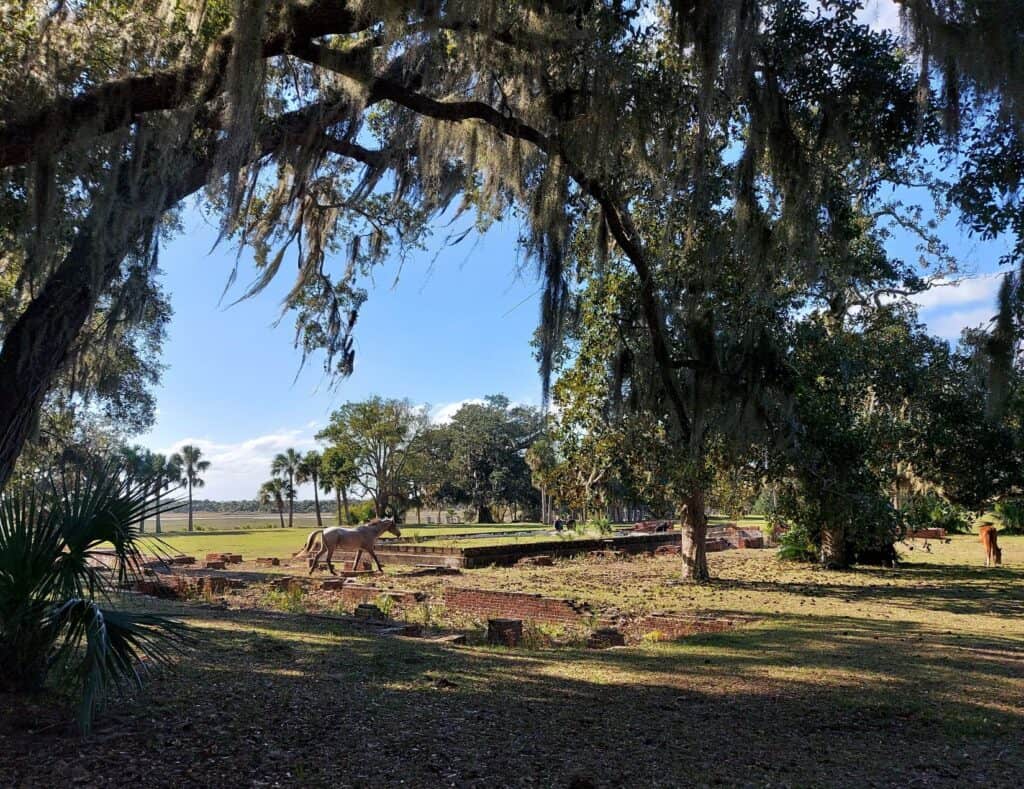Lucy Carnegie and Cumberland Island: A Great Lady’s Legacy
Do you know someone who is larger than life, a towering presence who leaves a lasting impression on all he or she meets? On Cumberland Island a century ago, Lucy Coleman Carnegie was that figure.

The sister-in-law to steel tycoon Andrew Carnegie, Lucy created an empire on Cumberland Island which she managed to control even after her January 1916 passing. In this article, we will explore the strong personality and eventful life of this remarkable woman.
Lucy Ackerman Coleman was born in Pittsburgh, Pennsylvania, in August 1847 to William Coleman, an iron manufacturing magnate, and his wife Nancy. Trim and short, this domineering young woman packed an abundance of spunk and good humor into her five-foot frame. At seventeen, she spent a year attending Linden Hall boarding school in Fernandina Beach, Florida, where she discovered the nearby island she would later call home.
In Pittsburgh, Lucy had throngs of beaus including Andrew Carnegie, a business partner of her father’s, and his younger brother Thomas. Andrew had promised at his mother’s insistence that he would not marry before her death, but Thomas was bound by no pact. It was he who caught Lucy’s eye, and the two married in Pittsburgh in June of 1866. Throughout their marriage, Thomas was devoted to “Lu” or “Lulu,” as he called her, and she to him, and by 1881 they had nine children together.
That year Thomas was considering retirement, and Lucy read about Cumberland Island in a flowery Lippincott’s Magazine article, which prompted them to visit the island’s South End. They were enchanted by its seclusion and natural beauty, and by 1882 Thomas had bought 4,000 acres comprising the Dungeness Estate (Catharine Greene Miller’s former plantation). He gifted it to his wife, who promptly persuaded him to buy another 8,200 acres.

The couple completed their 6,700-square-foot Queen Anne styled Dungeness Mansion on January 1, 1885, at a cost of more than $4.5 million in today’s currency. However, Thomas did not have long to enjoy it, as he died of pneumonia just one year after its completion. Thomas and Lucy had intended their home to be a winter getaway, but the newly-widowed Lucy decreed Dungeness to be her family’s full-time residence. She cemented her position by disinterring Thomas’s remains from their Pittsburg grave and transferring them to Cumberland.
She quickly put her stamp on the island, applying the names of family and friends to natural features, such as Lake Retta, a freshwater slough she named in honor of her daughter. She embellished the mansion’s immense gardens and also added a shooting range, duck houses, horse riding trails, roads, and gazebos on the beach, all while acquiring about ninety percent of the island. She even expanded the mansion to fifty-nine rooms and added a Queen Anne styled Recreation and Pool House in 1900 to host elaborate parties and house guests.
Upon her children’s maturing, Lucy so desired to keep them near her that she made an extraordinary offer: she would build each a Cumberland Island mansion of his or her own. Four of her children accepted, and Plum Orchard, Greyfield, and Stafford House are the results. She also built a 30-room mansion called the “Cottage” on the West Lawn of Dungeness for Morris, one of her favorite children, stipulating that his bedroom window face hers. When she raised her shades in the morning, he knew it
was time to visit, and the two would read together until noon. (This house no longer exists, having been destroyed by fire in 1949.)

On January 16, 1916, Lucy Carnegie died of pneumonia in her sleep at the age of 69. Her body was interred next to her husband’s in the Cumberland family cemetery, but even from the grave Lucy controlled the island. She had created a complicated trust under which none of the Carnegie lands or mansions could be sold while any of her children was alive. Thus, the family’s vast holdings remained intact until the death of the final Carnegie sibling in 1962.
One of Lucy’s grandsons commented on her strength of character: “When you look at Cumberland and see what she accomplished, she had to be strong willed.” Thanks to Lucy’s determination her Cumberland holdings were not broken up, and even after her trust had expired, most of her descendants chose to keep their land intact to honor her legacy. Therefore, Lucy Coleman Carnegie deserves much credit for Cumberland Island’s becoming a national park and place which belongs to us all.
Want to learn more about the Carnegies and their tenure on Cumberland Island? Come on a Cumberland Island Walking Tour! Learn more here.



